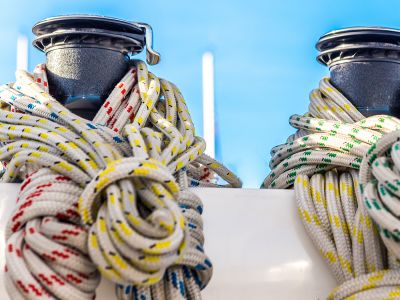
Essential sailing terms glossary
‘Hoist the mainsail!’
‘Starboard!’
‘Rig the anchor bridle’
Sailing can appear to be a forbidding sport, a confusing world filled with off-putting jargon and technical terms. There are rules, conventions, techniques, equipment, and traditions to learn. But cut through the clutter, and you discover a wonderful sport, full of freedom, adventure, and the thrill of the open sea.
When you learn to sail, you are literally shown the ropes and taught that they are called sheets, lines, warps, or painters. You learn that knots are hitches, and the stern is the back. Learning the sailing lingo is a rite of passage for many.
Sooner or later, that jargon becomes second nature, a clear method of communicating that helps you manoeuvre your yacht around the world’s most beautiful sailing areas. To help you master the basics, here is Sunsail’s definitive guide to the most important bits you need to know. Think you’re an expert? Keep an eye out for a few fun ones that may surprise even the saltiest of seadogs.
A
Anchor: One method of ‘parking’ your yacht, usually for a lunchtime stop in a quiet bay. A chain or line with a weighted hook on the end that grips the bottom of the sea floor and prevents your yacht from floating away
Apparent wind: A combination of the true wind direction and the headwind created by a yacht’s forward motion
Ashore: On the shore. Not on the yacht. Why are you not on the yacht?
B
Baggywrinkle: A soft covering for cables (or any other obstructions) that stops sails chafing
Bareboat: Bareboat is to sailing as free fall is to skydiving. Essentially it is sailing a yacht on your own. It is exhilarating, exciting and the rush of freedom is infectious
Beam: The width of the yacht
Berths: The number of people able to sleep on a specified yacht
Boom: The big, wide metal thing that sticks out from the mast at 90 degrees and is attached to the foot of the sail. Also the noise it makes when it hits you. Avoid this at all costs
Bow: The front of the yacht, not a pretty knot
Bridle: A system used to share the strain of an anchor evenly across two points. It reduces wear on the yacht, acts as a shock absorber, and silences the rattle of the anchor chain. Also helps prevent your catamaran from floating away
C
Cabins: Bedrooms on a yacht
Catamaran: A boat with two hulls
Chart: The map on which you check your position and plan your next voyage
D
Dinghy: Designed for quick trips between ship and shore. The small inflatable boat attached to the yacht
Draft: Not a type of beer. The minimum depth of water needed to float your boat
Dunsel: A part on a ship that has no use.
E
Ease: To let the sails out
F
Fender: The rubber bubbly thing dangling off the side of the boat or a pontoon to help prevent damage to the boat or pontoon
Flemish: To coil a line that is not in use so that it lies flat on the deck
Forepeaks: The forward section of the hull that, depending on the yacht’s design, may be used as a sleeping space or a storage area. Not a mountain range
Flotilla: A fun group sailing vacation with up 12 boats, with guidance and support from a lead boat with a Skipper, Engineer, and Host. This type of vacation is a Sunsail specialty.
G
Galley: The yacht’s kitchen
Genoa: The sail at the front of the yacht. Ours have a big red stripe around the outside. This sail is used to control the direction of the yacht, as well as adding some power. Not an Italian city
Gybe: To change from one tack to the other away from the wind, with the stern of the vessel turning through the wind
H
Halyard: The ropes used to pull things like sails up things like masts
Heads: Water closet, toilet, loo, dunny, the bog (you get it…)
Head to wind: See ‘In Irons’
Hold: The inside of the yacht’s hull
Helm: A tiller or wheel for steering the yacht. Also, a term to describe the helmsman.
Hull: The bit that floats. The main body, including the bottom and sides of a yacht. Not an English city
I
In Irons: See ‘Head to wind’; when the bow is pointing into the wind and the boat is difficult to manoeuvre under sail
Iron Mike: A slang term for auto-pilot. Not a famous boxer.
Itinerary: The intended route of travel on your flotilla or bareboat vacation. Usually planned in advance, these need to remain flexible to respond to weather conditions and personal preference
K
Keel: The central structural basis of the hull
Knot: Not just the loop you tie in a rope or string, but also a unit of speed (equal one nautical mile an hour)
L
Lazyjack: A network of cordage led from a point on the mast to points on the boom that help the sail to go down smoothly when lowered
LOA: Length overall – The maximum length of a yacht’s hull, including overhanging ends that extend beyond the main bow and main stern
LWL: Load waterline length – the length of a yacht that is in contact with the water.
M
Mainsail: The yacht’s main sail. This catches a lot of wind, and is where the majority of the yacht’s speed is generated when sailing
Mast: The big metal thing that soars from the bottom of the yacht into the sky. The sails are hoisted up it, using a complicated series of halyards
Med mooring: The art of reversing into a small gap and parking a yacht stern-to the quay. The typical mooring technique in most Mediterranean harbours. A great spectator sport
Monohull: A boat with one hull. The classic sailor’s yacht
Mooring: The second mode of ‘parking’- A buoy firmly anchored to the bottom, to which you are able to secure your yacht and prevents your yacht from floating away
N
Nautical Mile: A measure of distance on the water, equal to 1852 meters
Navigation: The art of working out (and occasionally planning) where you are and where you’re going
O
Ocean: very large body of water
P
Port: The left hand side of the boat when you face the front (bow). Not a fortified Portuguese wine
Prow: A poetical alternative term for bows
Q
Quay: A stone or metal platform lying alongside or projecting into the water for parking, loading and unloading yachts and ships
R
Reefing: The primary and preferred method of reducing sail area, to de-power the yacht so that it is easier to control. Especially useful in higher winds and choppy conditions.
Rip rap: A man-made pile of rocks and rubble. Used to form a breakwater, often surrounding an off-shore lighthouse or vulnerable harbour. Not a musical genre
S
Sails: The main driver of the yacht; an eco-friendly engine that converts wind power in boat speed by catching the breeze. Sailors constantly speak of trimming the sails to be as efficient as possible
Saloon: The living area, usually down below. Not a wild west bar
Skipper: The captain of your yacht
Starboard: The right-hand side of the yacht when you face the front (bow). Opposite of port
Stern: The rear of the yacht. Also, the skipper’s tone when your yacht floats away
T
Tacking: Zig-zagging so as to sail directly towards the wind (and for some yachts, also away from it)
Trampoline: You can try and bounce, but you probably won’t get very high. This is the netting at the front of the Catamaran that you can lie on and sun yourself
Trim: Adjustments made to sails to maximise their efficiency. Also refers to the position of hull relative to the waterline
True wind direction: Where the wind is actually coming from
W
Water: The wet, blue bit your yacht floats on
Waterline: The line where ship meets the sea
Winch: A rotating, horizontal drum, powered either by an electric motor or human cranking
Winch handle: The instrument used to crank a winch. Not a Two Ronnies sketch
Y
Yacht: Boat, ship, sailboat; the wooden, aluminium, fibreglass or carbon fibre thing that floats and is largely powered by the wind, which it catches in its sails
If this article is useful to you and you want to continue improving your sailing knowledge, then check out our range of sailing schools and courses in the UK and overseas.
Contributor
Ian Pedersen
Step Aboard Here
Start your experience with Sunsail on land and sign up to receive e-mails from us about yachts, offers and destinations.
By clicking 'Sign up' you confirm that you have read and understood our Privacy Policy and consent to our use of your information.



